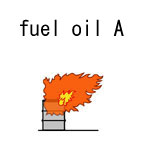| Case Name |
Leakage and fire of fuel oil from a flange between a heat exchanger and piping during shutdown operation at a vacuum gas oil hydrodesulfurization unit |
| Pictograph |

|
| Date |
May 11, 1995 |
| Place |
Kawasaki, Kanagawa, Japan |
| Location |
Refinery |
| Overview |
In May, 1995, temperature-lowering work, which was a part of shutdown operations for a vacuum gas oil hydrodesulfurization unit at T petroleum company, was carried out. At that time, the rate of temperature lowering increased, thermal strain was generated, and circulating A-grade fuel oil leaked from a flange between the heat exchanger and the piping, and ignited. An operation not in accordance with instructions was carried out, and it abnormally increased the rate of temperature lowering. |
| Incident |
Temperature lowering work was carried out during shutdown operations at the reaction section of a vacuum gas oil hydrodesulfurization unit atn a refinery. At that time, a leak occurred from a flange between a heat exchanger and piping, and there was a fire. |
| Processing |
Manufacture |
| Individual Process |
Maintenance |
| Chemical Reaction |
Other (hydro-desulfurization) |
| Substance |
Fuel oil |
| Type of Accident |
Leakage, fire |
| Sequence |
09:00 on May 10th, 1995; preparatory work for a shutdown began. The temperature at the outlet of the heating furnace was gradually lowered. Then, low-temperature A-grade fuel oil was introduced from outside and the fuel oil recycling operation was carried out.
About 06:30 on May 11th; Black smoke was confirmed on monitoring TV in the control room.
06:34; An emergency shutdown started. An emergency call was made to the fire-fighting department.
06:40; Public fire-fighters arrived.
07:58; The fire was extinguished. |
| Cause |
The temperature rapidly lowered during recycling operation for shutdown operation. Therefore, a gap was generated at the flange between the piping and the heat exchanger. A-grade fuel oil leaked from the gap and caught fire on contact with the adjacent heat exchanger. |
| Response |
The fire was extinguished during an emergency shutdown. Public and company fire-fighters cooperated in disaster-prevention activities. |
| Countermeasures |
Review of an operation manual at a turnaround shutdown. Thorough work management. |
| Knowledge Comment |
At facilities that operate at a high temperature, work to increase or decrease temperature is difficult. The piping is designed for installation at an ambient temperature, estimating to maintain its strength at the highest operating temperature.
When the temperature is raised or lowered, if work is hurried, an imbalanced heat distribution occurs, so thermal expansion differs at different locations, causing trouble. Warming and cooling should be done very slowly. |
| Background |
The workers ignored working instruction codes, so the rate of temperature lowering increased and strain was generated. A temperature-lowering operation manual indicated the receiving temperature of A-type fuel oil. According to the manual, first recycling operation is stopped temporarily, and then A-type fuel oil is received. However, the fuel was received while the recycling operation continued, so the rate of temperature lowering increased. The rate of temperature lowering was too high to keep a balanced temperature drop, and strain was generated. Although the cause was disobedience to working instructions, the reason why they did not work as directed is a problem. |
| Reason for Adding to DB |
Example of strain generated in piping caused due to a high-speed temperature drop |
| Scenario |
| Primary Scenario
|
Poor Value Perception, Poor Safety Awareness, Insufficient Recognition of Risk, Organizational Problems, Poor Management, Slackness of Management, Planning and Design, Poor Planning, Insufficient Schedule Management at Shutdown, Non-Regular Operation, Change in Operation, Operation Differ from Direction, Failure, Deformation, Shrinkage of Piping/Heat Exchanger, Secondary Damage, External Damage, Fire
|
|
| Sources |
High Pressure Gas Safety Inst. of Japan, High-pressure gas protection overview. pp.152-153 (1996)
Kawasaki City Fire station, Prevention section, Peace division, Outline of fire at desulphurization unit in K factory, T Co. Ltd. Material of the Kawasaki City complex safety countermeasure committee (1995)
|
| Physical Damage |
8 heat exchangers were destroyed by fire. |
| Field |
Chemicals and Plants
|
| Author |
KOSEKI, Hirosi (National Research Institute of Fire and Disaster)
TAMURA, Masamitsu (Center for Risk Management and Safety Sciences, Yokohama National University)
|
|